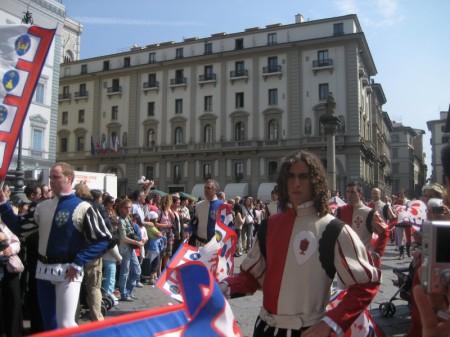April 29, 2007
Food of Tuscany III: Eating Out in Florence
Closing schedules can be a bit unpredictable and vary with the season. Phone ahead.
Top Choices
Trattoria Roberto, Via Castellani 4r (centro storico, near the Uffizi), 055 21 88 22. Excellent fish and seafood, carpaccio of smoked swordfish and salmon.
I’che c’e c’e (rough translation: “what you see is what you get”), Via Magalotti 11 (Santa Croce), 055 216 589. Very well prepared Tuscan favorites. Good ribollita. Excellent desserts (including the secret favorite: Catherine di Medici – fondant chocolate cake).
Trattoria Tre Soldi, Via G. d’Annunzio 4a/r (outside the center of town, in Le Cure), 055 679 366. Very well prepared and varied Tuscan style. Excellent tagliatte di manzo, panna (rich thick cream covered with fruit or chocolate).
Osteria Caffe Italiano, Via Isola delle Stinche 11 (Santa Croce), 055 289 368. Very well prepared Tuscan dishes. Excellent grilled duck breast. Ambitious wine list and wines by the glass.
Baldovino, Via San Giuseppe 22r (Santa Croce), 055 241 773. Very popular for good pizza. Excellent smoked fish carpaccio, excellent pasta, tortellaci with pesto.
Trattoria Antellisi, Via Faenza 9r (San Lorenzo), 055 216 990. Small selection of Tuscan standards and daily specials. Best ribollita in town. Fresh fish daily specials are excellent.
Trattoria Cibreo-Cibreino, via del Macci 122r (eastern Santa Croce), 055 234 11 00. Very small; does not take reservations. May need to arrive early or late or lucky to get a seat. This is the low-price counterpart of the expensive Cibreo. They share a kitchen and part of a menu. The antipasti are excellent: zuppe de pesce, polenta. Main courses can be excellent and interesting.
Top Choice Specialties
Gelateria: Vestri, Borgo degli Albizi (eastern centro storico)
Gelateria: Grom, Via delle Ocche (centro storico, two blocks from Duomo)
Pasticceria: La Loggia degli Albizi, Borgo degli Albizi (eastern centro storico)
Hot chocolate: Café Rivoire, Piazza della Signoria (centro storico). Unbelievably rich and chocolatey hot chocolate. Cognoscenti pay first at the cashier and drink at the bar (for a lower price than at the tables — but the tables have a view of the piazza). Available with cream (con panna) or without.
Food markets: The San Lorenzo and San Ambrogio markets are amazing. Dozens of butchers, delicatessens (salumerie), fish mongers, cheese stores, fruit and vegetable stands, with an amazing variety of foods.
Notable:
Aqua al Due, Via della Vigne Vecchia 40r (centro storico, next to Bargello), 055 284 170. Very popular. Immense degustazione (tastings of pasta and antipasti), good tagliatte di manzo.
Ristorante Toto, Via S.S. Apostoli (centro storico). Large ristorante, may not need to reserve. Good bistecca fiorentina, good pizza, carpaccio of fish affumicato.
Nerbone, in the Mercato centrale (San Lorenzo) lunch only. Legendary sandwiches.
Da Mario, Via Rosina 2r (San Lorenzo, a block from the Mercado Centrale; operates same days as the mercato) Lunch only.
Il Latini, via del Palchetti 6 (western centro storico), 055 21 09 16. Immensely popular, feels like a tourist trap. Reserve, then push to the head of the line to announce your reservation. The food is sound, including surprising edible Trippa al Fiorentinna.
Camillo, (Oltrarno), Borgo Sant’ Jacopo 57r, 055 21 24 27, sound trattoria.
Casalinga, (Oltrarno), via del Michelozzi 9r, 055 21 86 24, sound trattoria, authentic local clientele.

